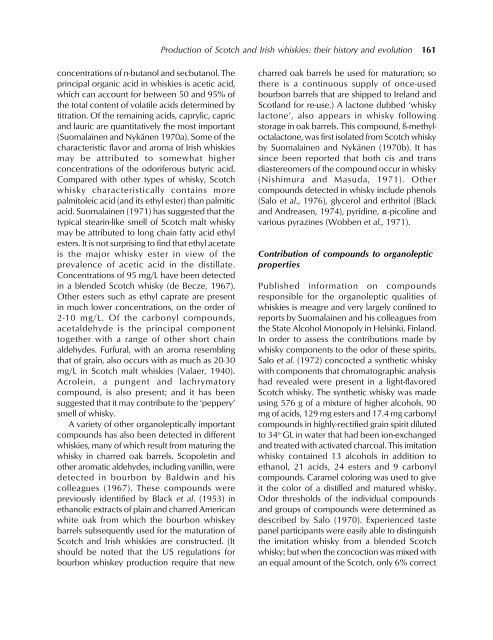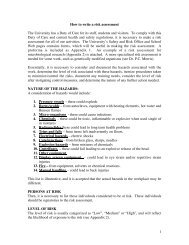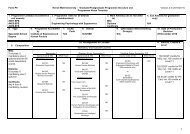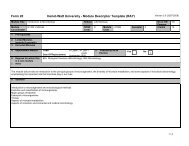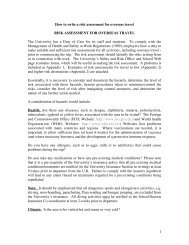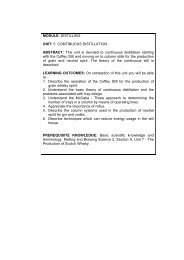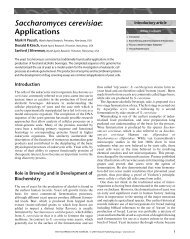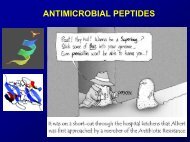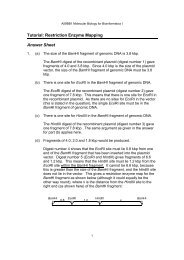Chapter 11 Production of Scotch and Irish whiskies: their history and ...
Chapter 11 Production of Scotch and Irish whiskies: their history and ...
Chapter 11 Production of Scotch and Irish whiskies: their history and ...
Create successful ePaper yourself
Turn your PDF publications into a flip-book with our unique Google optimized e-Paper software.
<strong>Production</strong> <strong>of</strong> <strong>Scotch</strong> <strong>and</strong> <strong>Irish</strong> <strong>whiskies</strong>: <strong>their</strong> <strong>history</strong> <strong>and</strong> evolution 161concentrations <strong>of</strong> n-butanol <strong>and</strong> secbutanol. Theprincipal organic acid in <strong>whiskies</strong> is acetic acid,which can account for between 50 <strong>and</strong> 95% <strong>of</strong>the total content <strong>of</strong> volatile acids determined bytitration. Of the remaining acids, caprylic, capric<strong>and</strong> lauric are quantitatively the most important(Suomalainen <strong>and</strong> Nykänen 1970a). Some <strong>of</strong> thecharacteristic flavor <strong>and</strong> aroma <strong>of</strong> <strong>Irish</strong> <strong>whiskies</strong>may be attributed to somewhat higherconcentrations <strong>of</strong> the odoriferous butyric acid.Compared with other types <strong>of</strong> whisky, <strong>Scotch</strong>whisky characteristically contains morepalmitoleic acid (<strong>and</strong> its ethyl ester) than palmiticacid. Suomalainen (1971) has suggested that thetypical stearin-like smell <strong>of</strong> <strong>Scotch</strong> malt whiskymay be attributed to long chain fatty acid ethylesters. It is not surprising to find that ethyl acetateis the major whisky ester in view <strong>of</strong> theprevalence <strong>of</strong> acetic acid in the distillate.Concentrations <strong>of</strong> 95 mg/L have been detectedin a blended <strong>Scotch</strong> whisky (de Becze, 1967).Other esters such as ethyl caprate are presentin much lower concentrations, on the order <strong>of</strong>2-10 mg/L. Of the carbonyl compounds,acetaldehyde is the principal componenttogether with a range <strong>of</strong> other short chainaldehydes. Furfural, with an aroma resemblingthat <strong>of</strong> grain, also occurs with as much as 20-30mg/L in <strong>Scotch</strong> malt <strong>whiskies</strong> (Valaer, 1940).Acrolein, a pungent <strong>and</strong> lachrymatorycompound, is also present; <strong>and</strong> it has beensuggested that it may contribute to the ‘peppery’smell <strong>of</strong> whisky.A variety <strong>of</strong> other organoleptically importantcompounds has also been detected in different<strong>whiskies</strong>, many <strong>of</strong> which result from maturing thewhisky in charred oak barrels. Scopoletin <strong>and</strong>other aromatic aldehydes, including vanillin, weredetected in bourbon by Baldwin <strong>and</strong> hiscolleagues (1967). These compounds werepreviously identified by Black et al. (1953) inethanolic extracts <strong>of</strong> plain <strong>and</strong> charred Americanwhite oak from which the bourbon whiskeybarrels subsequently used for the maturation <strong>of</strong><strong>Scotch</strong> <strong>and</strong> <strong>Irish</strong> <strong>whiskies</strong> are constructed. (Itshould be noted that the US regulations forbourbon whiskey production require that newcharred oak barrels be used for maturation; sothere is a continuous supply <strong>of</strong> once-usedbourbon barrels that are shipped to Irel<strong>and</strong> <strong>and</strong>Scotl<strong>and</strong> for re-use.) A lactone dubbed ‘whiskylactone’, also appears in whisky followingstorage in oak barrels. This compound, ß-methyloctalactone,was first isolated from <strong>Scotch</strong> whiskyby Suomalainen <strong>and</strong> Nykänen (1970b). It hassince been reported that both cis <strong>and</strong> transdiastereomers <strong>of</strong> the compound occur in whisky(Nishimura <strong>and</strong> Masuda, 1971). Othercompounds detected in whisky include phenols(Salo et al., 1976), glycerol <strong>and</strong> erthritol (Black<strong>and</strong> Andreasen, 1974), pyridine, "-picoline <strong>and</strong>various pyrazines (Wobben et al., 1971).Contribution <strong>of</strong> compounds to organolepticpropertiesPublished information on compoundsresponsible for the organoleptic qualities <strong>of</strong><strong>whiskies</strong> is meagre <strong>and</strong> very largely confined toreports by Suomalainen <strong>and</strong> his colleagues fromthe State Alcohol Monopoly in Helsinki, Finl<strong>and</strong>.In order to assess the contributions made bywhisky components to the odor <strong>of</strong> these spirits,Salo et al. (1972) concocted a synthetic whiskywith components that chromatographic analysishad revealed were present in a light-flavored<strong>Scotch</strong> whisky. The synthetic whisky was madeusing 576 g <strong>of</strong> a mixture <strong>of</strong> higher alcohols, 90mg <strong>of</strong> acids, 129 mg esters <strong>and</strong> 17.4 mg carbonylcompounds in highly-rectified grain spirit dilutedto 34 o GL in water that had been ion-exchanged<strong>and</strong> treated with activated charcoal. This imitationwhisky contained 13 alcohols in addition toethanol, 21 acids, 24 esters <strong>and</strong> 9 carbonylcompounds. Caramel coloring was used to giveit the color <strong>of</strong> a distilled <strong>and</strong> matured whisky.Odor thresholds <strong>of</strong> the individual compounds<strong>and</strong> groups <strong>of</strong> compounds were determined asdescribed by Salo (1970). Experienced tastepanel participants were easily able to distinguishthe imitation whisky from a blended <strong>Scotch</strong>whisky; but when the concoction was mixed withan equal amount <strong>of</strong> the <strong>Scotch</strong>, only 6% correct


